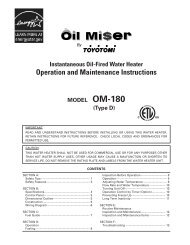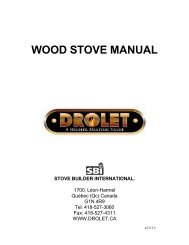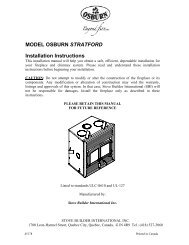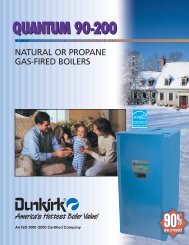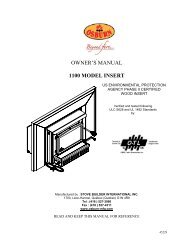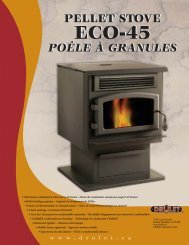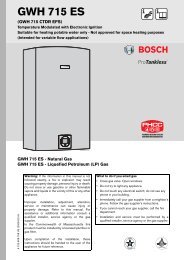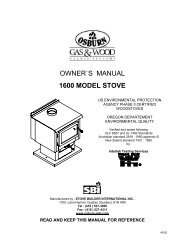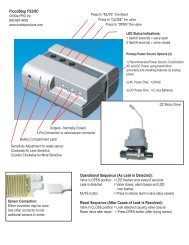Owner's Manual Osburn 2200 Wood Stove - Rural Energy ...
Owner's Manual Osburn 2200 Wood Stove - Rural Energy ...
Owner's Manual Osburn 2200 Wood Stove - Rural Energy ...
- No tags were found...
You also want an ePaper? Increase the reach of your titles
YUMPU automatically turns print PDFs into web optimized ePapers that Google loves.
OWNER`S MANUAL<strong>2200</strong> MODEL STOVEUS ENVIRONMENTAL PROTECTIONAGENCY PHASE II CERTIFIEDWOODSTOVEVerified and tested followingULC S627 and UL 1482 Standardsby:Manufactured by : STOVE BUILDER INTERNATIONAL INC..1700, Léon-Harmel, Québec (Québec) G1N 4R9Tel : (418 ) 527-3060Fax : (418 ) 527-4311www.osburn-mfg.comREAD AND KEEP THIS MANUAL FOR REFERENCE45055
INTRODUCTIONSBI INC., one of the most important wood stove and fireplace manufacturers in Canada,congratulates you on your purchase and wishes to help you get maximum satisfaction from yourwood stove. In the pages that follow, we will give you advice on wood heating and controlledcombustion as well as technical specifications regarding installation, operation and maintenanceof the model you have chosen.The instructions pertaining to the installation of your wood stove comply with ULC-S627 and UL-1482 standards.Read this entire manual before you install and use your new stove. If this stove is notproperly installed, a house fire may result. To reduce the risk of fire, follow the installationinstructions. Failure to follow instructions may result in property damage, bodily injury,or even death.Consult your municipal building department or fire officials about restrictions andinstallations requirements in your area and the need to obtain a permit.Keep this instructions manual for future references.CAUTIONS:• HOT WHILE IN OPERATION. KEEP CHILDREN, CLOTHING AND FURNITURE AWAY. CONTACT MAY CAUSESKIN BURNS.• DO NOT USE CHEMICALS OR FLUIDS TO IGNITE THE FIRE.• DO NOT LEAVE THE STOVE UNATTENDED WHEN THE DOOR IS SLIGHTLY OPENED.• DO NOT BURN WASTES, FLAMMABLE FLUID SUCH AS GASOLINE, NAPHTHA OR MOTOR OIL.• DO NOT CONNECT TO ANY AIR DISTRIBUTION DUCT OR SYSTEM.• ALWAYS CLOSE THE DOOR AFTER THE IGNITION.1
TABLE OF CONTENTSSECTION 1.0 - INSTALLATION...............................................................................................31.1 GENERAL INSTALLATION ...........................................................................................31.2.1 CANADA AND THE U.S.A. ........................................................................................31.2.2 AUSTRALIA AND NEW ZEALAND............................................................................51.3 RESIDENTIAL INSTALLATION INSTRUCTIONS .........................................................51.4 MANUFACTURED (MOBILE) HOME INSTALLATIONS – ADDITIONALREQUIREMENTS.....................................................................................................................61.5 CHIMNEY SYSTEM ......................................................................................................61.5.1 DEFINITIONS ............................................................................................................61.5.2 COMPONENTS .........................................................................................................71.5.2.1 FACTORY BUILT CHIMNEY SYSTEM ..................................................................71.5.2.3 RESIDENTIAL CLOSE CLEARANCES CHIMNEY SYSTEM.................................71.5.3 GENERAL INSTALLATION REQUIREMENTS..........................................................71.5.3.1 CONNECTORS ......................................................................................................81.5.3.2 CHIMNEY SYSTEMS.............................................................................................81.5.3.3 EXTERIOR CHIMNEY............................................................................................91.5.3.4 DRAFT..................................................................................................................101.5.4 TYPICAL TYPES OF CHIMNEY SYSTEMS ............................................................10SECTION 2.0 - OPERATION .................................................................................................122.1 SAFETY INFORMATION............................................................................................122.2 FUEL ...........................................................................................................................132.2.1 SIMPLE WOOD MOISTURE TEST .........................................................................142.3 NOTES ABOUT FIRST FIRING...................................................................................142.4 LIGHTING A FIRE .......................................................................................................142.5 MAINTAINING THE FIRE............................................................................................152.6 (OPTIONAL) FAN INSTALLATION AND OPERATION ...............................................16SECTION 3.0 - MAINTENANCE ............................................................................................163.1 CARE AND CLEANING...............................................................................................163.1.1 GLASS CLEANING..................................................................................................173.2 ASH REMOVAL USING ASH DRAWER .....................................................................173.3 CHIMNEY CLEANING.................................................................................................183.4 BAFFLE INSTALLATION AND BRICK NOTES ...........................................................193.5 SECONDARY AIR TUBE REPLACEMENT................................................................20SECTION 4- TROUBLESHOOTING ......................................................................................22SECTION 5 – SPECIFICATIONS...........................................................................................23LIMITED LIFETIME WARRANTY...........................................................................................242
Section 1.0 - InstallationWhen installed and operated as described in these instructions, the <strong>Osburn</strong> Model <strong>2200</strong> Bay <strong>Wood</strong> <strong>Stove</strong> issuitable for use as a freestanding wood stove in either residential or mobile home installations.The Model <strong>2200</strong> is not intended for installation in a bedroom.In Canada the CSA B365 Installation Code for Solid Fuel Burning Appliances and Equipment and the CSAC22.1 Canadian National Electrical Code are to be followed in the absence of local code requirements. Inthe USA the ANSI NFPA 70 National Electrical Code and NFPA 211 Standard for Chimneys, Fireplaces,Vents and Solid Fuel-Burning Appliances are to be followed in the absence of local code requirements.In addition to the national installation codes, local building and/or fire officials (or other authorities havingjurisdiction) should be contacted to determine what restrictions and installation requirements might locallyapply.1.1 General Installation1. Proper ventilation is required.2. Do not connect this unit to any air distribution duct.3. Connect the stove only to a lined masonry chimney conforming to national and local buildingcodes for use with solid fuel, or to a listed factory built chimney suitable for use with solid fuel.Clearances To Combustibles1.2.1 Canada and the U.S.A.Clearances to any combustibles when measured directly out from the front and up from the top ofThe stove must be a minimum of 48" (1219 mm). The stove must also be placed so as to maintainthe minimum clearances to combustible walls specified for the connector used. (See Table 1.1 andFigure 1.1).To Unit:Canada & USA usingSingle Walled ConnectorCanada & USA usingHorizontal Single WalledConnectorCanada & USA MobileHome & reduced clearanceinstallations using listedDouble Walled ConnectorSidewall A 17" (432 mm) 19" (483 mm) 20.5" (521 mm)Back wall B 13.5" (343 mm) 13.5" (343 mm) 6.0" (152 mm)Corner C 10" (254 mm) 10" (254 mm) 3.0" (76 mm)To Connector:Sidewall D 27" (686 mm) 29" (737 mm) 30" (762 mm)Backwall E 16" (406 mm) 16" (406 mm) 7.25" (184 mm)Corner F 20" (508 mm) 20" (508 mm) 13" (330 mm)Table 1.1 Minimum Clearances to Combustible Materials – Canada and the U.S.A.3
Figure 1.1 Clearances to Combustibles4
1.2.2 Australia and New ZealandClearances for Benja Mk 2 Flue Kit and Acorn Special Insulated Flue KitTo Unit:Side Wall A 450 mmRear Wall B 125 mmCorner C 75 mmTo Connector:Side Wall D 704 mmRear Wall E 189 mmCorner F 329 mmTable 1.2 – Clearances to Combustible Materials – Australia and New Zealand1.3 Residential Installation InstructionsChoose a location for the unit which meets the minimum clearances to combustibles (see Table 1.1). Forother than masonry chimneys determine if the factory built chimney will pass between the ceiling joists; ifnot, choose a new location so that it will, while still maintaining the minimum clearances.1. Mark the location for the floor protection ‡ (if required) as noted in Figure 1.1.Note: If outside air for combustion is to be used it should be provided for at this time. This requires that the<strong>Osburn</strong> Fresh Air Kit <strong>Wood</strong> (#OA10500) be installed (refer to the installation instructions which areprovided in the outside air kit. Install the unit.Floor Protection Requirements (for combustible floors)If the stove is to be installed on top of a combustible floor it must be guarded by a non-combustiblematerial extending beneath the heater and to the front and sides as indicated in Figure 1.1, or to the nearestpermitted combustible material. Floor protection must extend beneath, and 2” (51 mm) to the sides of ahorizontal connector if one has been used.Please note that floor protection is required under the pedestal models for spark and ash shielding, but notfor limiting floor temperatures from the radiant heat of the stove. The stove was designed and safety testedso that without any protection the floor would not overheat even under over firing conditions. Please referto local codes for suitable floor protection materials.5
1.4 Manufactured (Mobile) Home Installations – Additional Requirements1. The stove must be bolted to the floor (secure the unit by prying out the two plastic plugs in thepedestal, and installing the two 3/8" x 3-1/2" (9.8mm x 88.9mm) lag bolts through the holesprovided).2. The unit must be provided with outside combustion air.3. Clearance from the top of stove to an unprotected ceiling should be a minimum of52” (1321mm).Note: For manufactured home installations in the USA, the stove must be grounded to the frame ofthe home using a # 8 ground wire with approved terminations and star lock washers.CAUTION: THE STRUCTURAL INTEGRITY OF THE MANUFACTURED HOME FLOOR, WALL, CEILING /ROOF MUST BE MAINTAINED.CAUTION: DO NOT INSTALL IN A SLEEPING ROOM.1.5 Chimney System1.5.1 DefinitionsFor clarity, the following definitions should be used with respect to these instructions:A chimney system consists of the connector off the top of the stove, and a chimney, which joins to theconnector and terminates outside the building envelope.A chimney can be a masonry chimney (of masonry construction with an inside liner), or a factorybuilt chimney.A factory built chimney can be a double walled chimney (two concentric pipes with insulationsometimes referred to as an insulated solid pack, or an air cooled chimney (three concentric pipes,with insulation between the first and second pipes, and air between the second and third pipes).A single walled connector is a single pipe.A double walled connector has two concentric pipes, no insulation, and is an air cooled connector.6
1.5.2 ComponentsNOTE: All connector and manufactured chimney components must be LISTED COMPONENTS.Masonry Chimneys must be Code Complying, and have a listed solid fuel burning liner (of stainlesssteel or clay refractory construction).1.5.2.1 Factory Built Chimney SystemThe following are the generic components required for a factory built chimney system forresidential installations:Chimney – in the USA use a 6” diameter (152 mm) listed UL 103 HT chimney system andcomponentsChimney – in Canada use 6” diameter (152 mm) listed ULC S629 chimney system and componentsManufactured (Mobile) Home Chimney SystemIn addition to the requirements of section 1.5.2.1 the following components are required formanufactured (mobile) home installations:A spark arrestor must be employed with the rain capDouble walled connectors must be used instead of single walled connectorsFor manufactured (mobile) home installations in the USA only and where the chimney system hasemployed a solid pack chimney, a vented roof flashing must also be used.1.5.2.3 Residential Close Clearances Chimney SystemIn addition to the requirements of section 1.5.2.1 the following components are required forresidential close clearances installations:Double walled connectors must be used instead of single walled connectors1.5.3 General Installation RequirementsCAUTION: DO NOT FILL ANY FRAMED SPACE AROUND THE FACTORY-BUILT CHIMNEY WITHINSULATION OR ANY OTHER MATERIAL. INSULATION PLACED IN THIS AREA COULD CAUSE ADJACENTCOMBUSTIBLES TO OVERHEAT.DO NOT USE MAKESHIFT COMPROMISES DURING INSTALLATION AS THEY MAY BE SAFETY HAZARDS,AND A FIRE COULD RESULT.DO NOT CONNECT THIS UNIT TO A CHIMNEY SYSTEM SERVING ANOTHER APPLIANCE.7
DO NOT CUT RAFTERS OR CEILING JOISTS WITHOUT FIRST CONSULTING A BUILDING OFFICIAL TOENSURE STRUCTURAL INTEGRITY IS NOT COMPROMISED.1.5.3.1 ConnectorsThe minimum connector diameter is 6" (152 mm). A minimum connector length of 4 ft (1.22 m) isrecommended for best results. Restrictions to stack gas flow (such as using more than two 90 oelbows) should be avoided and any horizontal runs should be kept to a minimum length, especiallywith short chimneys. The connector pipe, which joins the unit to the chimney, may be of eithersingle or double walled construction. Connector pipe should be a minimum of 24-gauge steel.The connector pipe itself must not pass through any combustibles, nor may it pass through noncombustiblesand into a concealed space (such as an attic, roof space, or closet). If passing througha wall, ceiling, or into a masonry chimney, use either chimney components listed for that specificuse, or means acceptable to local authorities having jurisdiction over the installation.Install sections of single wall or double wall connector between the stove and the chimney. Secureall connector pipe joints with a minimum of three sheet metal screws. All connector and factorybuilt chimney pipes must be installed with the male or crimped end down to prevent creosotedripping outside the joints. If non-telescopic sections are to be used, they must be cut to length,allowing for overlap. Use three (3) screws to attach the connector section to the flue collar of thestove. Listed double walled connectors should be installed in accordance with the ventmanufacturer’s installation instructions.Figure 1.2 - Joints in Chimney System1.5.3.2 Chimney SystemsThe minimum chimney size is 6" (152 mm) in diameter. The minimum overall height of thechimney system, measured from the base of the appliance is 12' (3.66m). Existing masonry andmetal chimneys should be inspected to check for deterioration and to determine if they meet theminimum installation requirements; they should be upgraded if necessary. In Canada, masonrychimneys must have or use a ULC S635 listed Class III liner in chimney systems that are not ULCS629 listed. Similarly in the USA a UL 1777 listed refractory or metallic liner must be used. Atthe point of penetration through the roof to the outside of the building envelope, the chimney mustextend at least 3' (914 mm) above the roof and at least 2' (610 mm) above the highest point withinan area of 10' (3 m) of the chimney (see Figure 1.3).8
Follow CSA Standard B365-M91 for methods and precautions to be employed when connectingthe stove to a masonry chimney, and for installing thimbles (wall penetration assemblies) when theconnection from the stove to the masonry chimney is made through a combustible wall.When connecting to a factory built chimney, ensure that it is installed according to themanufacturer's listed instructions. If using an existing chimney, inspect and clean the chimney ifrequired (this should be done by a licensed chimney sweep or a qualified professional).Figure 1.3 – Chimney height1.5.3.3 Exterior ChimneyChimneys constructed outside of the home on an exterior wall should be avoided if possible,especially in colder climates. Exterior chimneys may not draft well and in fact may down draft(reverse flow) due to the difficulty in heating them up to operating temperature while trying toevacuate the stack gases. All else being equal, cooler chimneys will have less draft than hotterones; this may lead to creosoting and poor performance. If an exterior chimney is used to removethe stack gases the best results will be obtained by using a connector vertically off the unit to thehighest possible point before elbowing off horizontally to the chimney. For efficiency and safetyreasons the stove must not be installed with an insulated chimney connected directly to theappliance.9
1.5.3.4 DraftYour <strong>Osburn</strong> stove will attain its best performance if installed with a chimney system that hasproper draft. (Draft is the force that moves air from the appliance up through the chimney and ispredominantly affected by the height and diameter of the chimney, and the stack temperatures ofthe stove). If you test the draft using a pressure gauge, the reading should be between .05 - .07inches of water column (w.c.) at a medium high fire. (See Table 2.2). Drafts of less than .03" w.c.will cause operation difficulty while too much draft (greater than .10" w.c.) will result in overfiringof the stove. This can result in excessive operating temperatures. If this is the case, a manualdamper may be installed in the vertical connector pipe to help reduce excessive draft.Figure 1.4 Connection to a Masonry Chimney (Exterior Shown)1.5.4 Typical Types of Chimney SystemsThere are basically two types of chimney systems; one employs an existing masonry chimney,while the other employs a manufactured or factory built chimney. In either system the chimneymay be of an interior or an exterior type. The following illustrations are provided to demonstratethe basic components required for a proper and safe installation. The components identified maynot appear exactly as those purchased – the manufacturers’ installation instructions and specifiedclearance distances should always be followed in accordance with local and national installationcodes. In Canada the CSA B365 and the CSA C22.1 installation codes are to be followed. In theUSA the ANSI NFPA 70 and ANSI NFPA 211 installation codes are to be followed.10
Figure 1.5 Connections to a Factory Built Chimney (Interior Shown)Figure 1.6 Connection to a Factory Built Chimney (Exterior Shown)11
Section 2.0 - Operation2.1 Safety Information1. This stove is designed for safe operation WHEN BURNING CORDWOOD ONLY. Altering ormodifying the unit or installation without proper authorisation will void the certification,warranty, and safety listing, and may result in a safety hazard.2. For safety reasons, never leave the unit unattended with the door open or ajar. An opendoor, and especially a door partially open or cracked, if left for longer than required forgood ignition can potentially result in unsafe chimney temperatures, and if left unattendedin hot embers or ignited fuel falling out of the unit. Prolonged door open operation is notnecessary provided the unit has been properly installed and dry kindling is used to start thefire.3. Do not abuse the unit, either by over firing or by using wood or combustibles with saltcontent, or harmful chemicals. Misuse is not covered by warranty.4. Even though your <strong>Osburn</strong> has been specifically designed and tested to prevent smokespillage, always open the door slowly as this will minimise the likelihood of smoke spillageor a back draft of flame or smoke into the room.5. Never use gasoline type lantern fuel, kerosene, solvents, charcoal lighter fluid, orinflammable liquids to start or "freshen" a fire in the stove. Keep all such liquids well awayfrom the stove while it is in use.6. All stove surfaces become very hot during operation. Care is needed, especially withchildren, to avoid contacting these surfaces.7. Do not elevate the fire by means of grates.8. CAUTION: DO NOT OVER FIRE THIS HEATER. Do not burn fuel in the stove at a rate higherthan that which will cause the ember bed level to exceed half the door opening height. Ifburning hot fires regularly, purchase a stovetop thermometer, and do not exceed 840 o F(450 o C) as measured on the Cook top. If the door handle of the stove becomes excessivelyhot to the touch, consider this to be an indication of over firing. Over firing can result in asafety hazard and can permanently damage the stove and chimney. This damage is notcovered by the warranty.9. Although the ceramic glass is extremely durable under any normal use, a few precautionsare required. Do not attempt to push logs further into the fire by using the door, as the glassmay break if any solid object heavily contacts it.10. Never operate the stove with the door open, or cracked slightly open, except briefly during12
the lighting operation, and during refuelling. Leaving the door open continuously couldseriously overheat the chimney and adjacent combustibles. Do not operate the stove ifthere is an abnormal air leakage into the stove, such as through deteriorated gaskets orcracked or broken glass. Do not operate the stove without a door gasket. Leakage canresult in overheating, or in very airtight homes, could possibly cause smoking into theroom. Smoke may contain carbon monoxide, which is poisonous, and in sufficientquantities is a health hazard.2.2 Fuel1. Fuel for the stove must not be stored closer than the required clearances to combustiblesand not in the space required for charging and ash removal.2. Your <strong>Osburn</strong> stove is designed to burn CORDWOOD FUEL ONLY. Do not burn coal, charcoal,or trash in the unit. Highly flammable items such as trash may ignite creosote in thechimney, resulting in a chimney fire. Never burn salt wood, beach wood, chemicallytreated wood, or wood removed from salt water, since the deposits left will deteriorate thefirebox. Damage caused by chemicals or salt is not covered under warranty.3. Seasoned dense wood is recommended. <strong>Wood</strong> should be air dried in a covered ventilatedarea for six months to a year or more. This reduces the moisture content of the wood,resulting in better stove performance. <strong>Wood</strong> species with moisture content of 20% or lessare ideal. Dry seasoned wood can be distinguished from green wood by the checks orcracks in the ends.4. Wet or green wood will tend to cause the fire to smoulder, producing large amounts ofcreosote. Creosote buildup could result in a chimney fire. This wood will also provedifficult to keep burning properly, and fires will tend to go out. Green wood produces verylittle heat, and sometimes causes customers to think that the stove does not work. If youmust burn wet wood, use only small amounts mixed with dry wood.5. Decayed wood or low-density wood has very little energy content or heating value, and willnot burn satisfactorily for long periods of time.An example of the energy values of some common wood fuels is given in Table 2.1For recommended wood sizes, refer to the specifications.Table 2.1 Common Heating Values of CordwoodHardwoods Million Btu/Cord Softwoods Million Btu/CordBirch 23.6 Douglas Fir 20.6White Oak 28.3 Hemlock 17.1Alder 17.6 Jack Pine 18.413
2.2.1 Simple <strong>Wood</strong> Moisture TestAdd one large piece of wood to the top of an established fire. If it starts to burn on three sides.Within one minute, it is dry and seasoned and right for burning. If it turns black and starts toburn.In three minutes, it is damp. If it turns black and does not start burning until after five minutes, itIs green and wet. If it hisses at any time the wood is soaked and will not burn until excessmoisture is boiled away.2.3 Notes About First FiringBefore firing ensure that the room is well ventilated. Curing the paint is recommended to preservethe best quality finish. Heating the stove up too intensely on the first fire will dull and lighten thecolour on overheated areas, and cause smoke and odour to be emitted into the room. To cure thepaint, the first two fires should be burned for only about twenty minutes each.Allow the stove to get warm only but not hot, i.e. 250 o F (120 o C) as measured by a stovetopthermometer, and allow the stove to cool down. Light a third fire and burn it for about fortyminutes to 450 o F (230 o C) or less. Once again cool the stove to room temperature, then operate itaccording to the following instructions. This extra care will result in a more durable, and uniformfinish.2.4 Lighting A Fire1. Place enough crumpled balls of newspaper or other paper into the stove to cover thebottom of the firebox.2. Place small dry kindling on the crumpled paper.3. Place larger dry kindling on top of the small kindling.4. Open the draft control fully to the right (located on the front of the stove, Figure 2.1)5. Light a fire at the bottom of the crumpled paper and close the door. If the fire tends to goout, momentarily hold the door slightly ajar to fan the fire. As soon as the fire catches hold,close the door.6. Ideally the large kindling should be burned until a thick bed of red embers is obtained. Atthat point, add cordwood fuel and continue to operate the draft control wide open until thefire is well established. Once the firebox is hot, the draft control can be partially closed bymoving the handle to the left to adjust the intensity of the fire.14
Use Table 2.2 to adjust the draft control to the desired burn rate:Burn RateLowMedium LowMedium HighHighDraft SettingMove Control against the L.H. side.Move Control right by 9/16” – 1” (14.3 – 25.4mm) from closed position.Move Control right by 7/8” - 1 3/4” (22.2 – 44.5mm) from closedpositionMove Control against the R.H. sideTable 2.2 Draft SettingsClosing the draft control down too soon will lower combustion efficiency, and may result in creosotebuild-up in the chimney (which could lead to a future chimney fire).CAUTION: THE ADJUSTMENT RANGE SHOULD NOT BE ALTERED FOR INCREASED FIRING FOR ANY REASON.2.5 Maintaining The FireFigure 2.1 Draft controlYour <strong>Osburn</strong> stove will work best if a thick bed of hot embers is maintained in the bottom of thefirebox, and a minimum of two large pieces of seasoned fuel are added. Combustion efficiency islargely related to establishing a hot ember bed, and hot firebox temperatures. The quicker the stoveand fuel get up to operating temperature, the better. A small intense fire is preferred to a largesmouldering fire, both to improve combustion efficiency and to reduce the amount of creosoteemitted. The best performance will be obtained by adding relatively small amounts of fuel to awell established ember bed, and then operating with the air inlet control open long enough toachieve a hot fire. Cordwood should be placed with air in between individual pieces. Use a pokerto make an air channel in the embers below the wood, this will allow air to flow under the wood for15
a more efficient burn.Extended burn times can be accomplished by first operating the stove on a full load with the airinlet controls wide open. Once the fire is well established, and the moisture has been driven out ofthe wood, reduce the air control to a low setting. The unit should then burn cleanly withoutsmoldering. If the fire smolders without flame, re-establish a hotter fire before moving the aircontrol to the low setting. A yellow flame burning in the top of the firebox is a good indication of aclean efficiently burning fire.Refuelling technique is important for good performance. The best efficiency and performance fromyour stove can be achieved by adding partial loads of fuel and allowing them to get up to operatingtemperature before adding additional fuel. Adding a large amount of fuel at one time will increasethe time required to get the fuel up to its ignition temperature, and an extended time to reachoptimal performance. When refueling, open the air control or hold the door partially open 1” (25mm) or less long enough (less than 5 minutes) so that the fire has well established flames. Whenrefuelling, care is required to ensure that fuel or embers do not fall out of the door opening. Theunit will burn at about 2.0 to 2.5 lb/hr (.9 to 1.1kg/hr) at its minimum setting; approximately 20 to25 lbs (9 to 11.3kg) of wood are required for an extended burn.2.6 (Optional) Fan Installation and Operation1. Allow the stove to reach operating temperature (approximately one hour), before turning onthe fan, since increased airflow from the fan will remove heat and affect the start-upcombustion efficiency.NOTE: ENSURE THE FAN CORD IS NOT IN CONTACT WITH ANY SURFACE OF THE STOVE TOPREVENT ELECTRICAL SHOCK OR FIRE DAMAGE. DO NOT RUN CORD BENEATH THE STOVE.2. Turn the fan on or off with the two speed switch located on the fan housing. The switchsettings are High, Off, and Low.3. Follow the installation instructions that are with the fan kit #OA10510.Section 3.0 - Maintenance3.1 Care And CleaningClean the stove frequently so that soot, ash and creosote do not accumulate. Do not attempt toclean the stove, glass or door when the unit is hot. Special care must be taken with Gold surfaces inorder to maintain the finish at its original brilliance. Do not use an abrasive glass cleaner whichwill scratch the glass or gold finish. Use only a soft clean damp cloth on the door, since somecleaners may remove the plating or paint.16
3.1.1 Glass CleaningUnder normal operation the glass is designed to stay clean. Glass cleaning may be required whenburning damp wood and/or when burning slow fires. In general if the glass is not staying cleanthen the unit is being under fired. Dirty glass may be self cleaned by burning a hot fire (i.e. drywood and opened draft controls) for a couple of hours. Good burning techniques will result inclean glass.Hand clean the glass only when the fire is out and the stove is cold. A light film can usually becleaned with paper towel and water. If heavy cleaning is required, a ceramic glass cleaner or polishis recommended, and should be rinsed off with water for best results.3.2 Ash Removal Using Ash DrawerCAUTION: ASHES CAN START FIRES, EVEN AFTER SEVERAL DAYS OF INACTIVITY. NEVER DISPOSE OFASHES IN A COMBUSTIBLE CONTAINER. REMOVE ASHES ONLY. WHEN STOVE AND ASHES ARE COLDWhenever the ashes get 3 – 4” (76 – 102 mm) deep in the firebox, they should be emptied into theAsh Drawer, using the following instructions:1. Make sure the fire is out, and the stove is cold.2. Lift the ash dump plug at the left rear of the firebox by hooking the poker through the loopon the cover and lifting up.3. Push the ashes through the hole and leave some ashes to cover the ash dump plug once it isreplaced. Leave an ash bed of approximately 1” deep on the firebox bottom to help maintain ahot ember bed.Figure 3.1 Ash removal17
4. Clear the ashes from the area where the plug normally sits so that it will properly seatagainst the opening edges; tap it down with your poker to ensure proper seating.5. Cover the plug with the remaining ashes and continue operation of your stove as usual. TheAsh Drawer is shown in Figure 3.1 and can be removed by pulling it out toward you. Lift theAsh Drawer slightly or the pedestal base may get scratched. Close the rear half of the AshDrawer lid to prevent spillage. Ashes should be placed in a metal container with a tightlyfitting lid. This closed container should be placed on a non-combustible floor or on the ground,well away from all combustible materials, pending final disposal. Ensure the rear half of the lidis open before replacing the Ash Drawer.If the ashes are disposed of by burial in soil or otherwise locally dispersed, they should be retainedin the closed container until all cinders have thoroughly cooled. Do not place other waste materialsin the metal ash container. If bright embers are glowing above the ash dump port during a low ormedium low fire, air may be leaking past the ash plug. If this is happening, a possible over firehazard exists. The stove should be shut down and allowed to cool. Properly seal the ash dumpplug to the stove.3.3 Chimney CleaningRegular chimney maintenance, as well as good burning practices, are required to prevent chimneyfires. The chimney and the chimney connector pipe must be maintained in good condition and bekept clean in order to be safe. This means that the chimney should be checked regularly forcreosote build-up. Inspection and cleaning of the chimney is facilitated by a removable baffle.CAUTION: OPERATION OF YOUR OSBURN <strong>2200</strong> WITHOUT THE BAFFLE MAY CAUSE UNSAFE ANDHAZARDOUS TEMPERATURE CONDITIONS AND WILL VOID THE WARRANTY.Contact your local, municipal, state, or provincial fire authority for information on how to handle achimney fire before there is any chance that it may happen.When wood (especially green wood) is burned without adequate heat or air supply, it producestar and other organic vapours (smoke), which combine with expelled moisture to form creosote.The creosote vapours condense in the relatively cool chimney flue of a slow-burning fire. As aresult, creosote residue accumulates on the flue lining. When ignited, this creosote makes anextremely hot fire which could be hazardous. Check frequently for creosote build-up. In the eventof a stove or chimney component failure, replace only with equipment that is equivalent to theoriginal, available from your <strong>Osburn</strong> dealer.18
Your <strong>Osburn</strong> stove has been designed to reduce the amount of creosote produced. Even so, thechimney connector pipe and chimney should be inspected at least once every two months duringthe heating season to determine if a creosote build-up has occurred. If creosote has accumulated, itshould be removed to reduce the risk of chimney fire. Call a professional chimney sweep, or go toyour local <strong>Osburn</strong> dealer, purchase a chimney brush, and have the chimney cleaned.3.4 Baffle Installation and Brick Notes1. The following items are shipped inside the firebox: five full bricks, five cut bricks, rearbaffle support, front baffle support and stainless steel air tube c/w cotter pin, and two baffleboards.2. Install rear baffle support, locating on baffle support tabs welded to side plenums.3. Install five cut bricks starting with outermost bricks first (4” dimension goes front to rear).Push rear baffle support towards rear of firebox.4. Install baffle boards above secondary air tubes.5. Install front baffle support/extension, ensuring extension fits between front risers.6. Install five full bricks, starting with outermost bricks first. See Figure 3.2a7. Ensure baffle boards are located as per Figure 3.2.8. Install secondary air tube ensuring air holes face forward. Install cotter pin as perFigure 3.49. Remove in reverse order.Figure 3.2 – Baffle installation & removal19
Figure 3.2a – Firebrick Baffle InstallationAll firebrick and duraboard baffles must be properly in place for correct burning operation. Have anydamaged firebricks replaced. Check the firebricks annually for damage and replace if they are broken ordamaged. See Figure 3.3 for the firebrick layout. Install the side & back firebricks first, and then thebottom firebricks.3.5 Secondary Air Tube Replacement(See Figure 3.4)1. Remove cotter pin at LH end of tube.Figure 3.3 – Firebrick layout2. Slide tube to right and lower tube end below LH plenum.3. Slide tube to left to remove.4. Reassemble in reverse order using a new cotter pin. The cotter pin is a hammerlock style andlocks into place by hitting the head sharply with a hammer.20
5. Note that any tube can be replaced without disturbing the baffle.Important Notes:The air tubes are identified for placement as follows:Front to back:Tube No. 1 67 Holes of .156” diameterTube No. 2 67 Holes of .140” diameterTube No. 3 67 Holes of .140” diameterTube No. 4 67 Holes of .125” diameterFigure 3.4 – Secondary Air Tube replacement21
Section 4- TroubleshootingSymptom Possible Cause Corrective ActionI Smoke in room 1. Down draft 1. Upgrade chimney2. Chimney blocked 2. Clean chimney3. Chimney damper shut 3. Open or remove damper4. Baffle out of position 4. Correctly position baffle5. New paint is curing 5. Refer to instructionsII<strong>Wood</strong> burnspoorly or is slowto start or noheat1. Low draw2. Wet or decayed wood3. Blocked intake air1. Upgrade chimney2. Use proper fuel3. Check intake air supply byremoving ash drawer frompedestal and opening awindowIII Dirty glass 1. <strong>Stove</strong> is being under fired 1. Refer to instructionsIV<strong>Wood</strong> burns toofast1. Too much draft inchimney1. Consult a qualifiedtechnician22
Section 5 – SpecificationsFuel TypeTest StandardsHeat OutputRangeShipping WeightCordwoodULC S627 (CSA B366.2) & UL 1482 residential and mobile home.AS/NZS 4013:1999 when tested in accordance with AS/NZS 4012:199911,717 – 30,437 BTU/Hr (at 63% default efficiency). BTU/Hr outputwill vary with usage depending on the type and condition of cord wood.Maximum average heat output burning hardwood (Australia) 6.8 kW, efficiencyon low – 61%, high – 49%385 lbs (175 kg)Firebox Volume 2.2 cu.ft. (0.062 m 3 )Firebox Floor AreaDoor Opening SizeRecommendedLog SizeFlue Outlet18 3/16 x 17 (478mm x 431mm)21.2" wide x 9.2" high (538 mm wide x 234 mm high)18" x 6" Dia. (457 mm x 152 mm) if loading sideways16" x 6" Dia. (406 mm x 152 mm) if loading front to back6" (152 mm) diameter (vertical or horizontal)Optional - Fan Kit OA10510Components - Fresh Air Kit OA1050023
1700, rue Léon-Harmel, Québec (Québec) G1N 4R9tel. : (418) 527-3060 fax : (418) 527-4311e-mail : tech@osburn-mfg.com web site : http://www.osburn-mfg.comLIMITED LIFETIME WARRANTYThe warranty of the manufacturer extends only to the original consumer purchaser and is not transferable. Thiswarranty covers brand new products only, which have not been altered, modified nor repaired since shipment fromfactory. Proof of purchase (dated bill of sale), model name and serial number must be supplied when making anywarranty claim to your OSBURN dealerThis warranty applies to normal residential use only. Damages caused by misuse, abuse, improperinstallation, lack of maintenance, over firing, negligence or accident during transportation are notcovered by this warranty.This warranty does not cover any scratch, corrosion or discoloration caused by over firing, abrasives or chemicalcleaners. Any defect or damage caused by the use of unauthorized parts or others than original parts void thiswarranty.An authorized qualified technician must perform the installation in accordance with the Instructions supplied with thisproduct and all local and national building codes. Any service call related to an improper installation is not covered bythis warranty.Returned products are to be shipped prepaid to the manufacturer for investigation. If a product is found to bedefective, the manufacturer will repair or replace such defect and reasonable transportation fees will be refund.Repair work covered by the warranty, executed at the purchaser domicile by an authorized qualified technicianrequires the prior approval of the manufacturer. Labour cost and repair work to the account of the manufacturer arebased on predetermined rate schedule and must not exceed the wholesale price of the replacement part.The manufacturer at its discretion may decide to repair or replace any part or unit after inspection and investigation ofthe defect. The manufacturer may, at its discretion, fully discharge all obligations with respect to this warranty byrefunding the wholesale price of any warranted but defective partsThe manufacturer shall in no event be responsible for any special, indirect, consequential damages of any nature,which are in excess of the original purchase price of the product.WARRANTY APPLICATIONDESCRIPTION PARTS LABOURCombustion chamber (weldings only) Lifetime 5 yearsStainless baffle 5 years 1 yearCarbon steel baffle and secondary air tubes 2 years 1 yearHandle assembly 5 years n/aAsh drawer Lifetime 1 yearCast iron parts 5 years 1 yearCeramic glass (thermal breakage only) 1 year n/aPaint, refractory bricks, gasket, blower, thermal switch (thermodisc)and rheostat1 year n/aGold plating (tarnishing) / Brass plating not covered 1 year n/aShall your unit or a components be defective, contact immediately your OSBURN dealer. Prior to your call make sure you havethe following information necessary to your warranty claim treatment:• You name, address and telephone number;• Bill of sale, dealer’s name;• Serial number and model name as indicated on thenameplate fixed to the back of your unit;• Nature of the defect and any relevant information.Before shipping your unit or defective component to our plant, you must obtain from your OSBURN dealer anAuthorization Number. Any merchandise shipped to our plant without authorization will be refused automatically andreturned to sender.24



